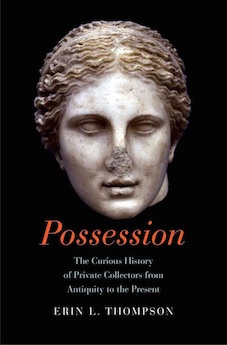Shortlisted for the 2017 Ralph Waldo Emerson Award
By Allen D. Boyer
This is a slim and thoughtful book – a subtle study of mania, mistake, fraud, and vandalism.
For twenty-three centuries, Erin Thompson warns, private collectors have played a dubious role in the history of art. To claim a place in the Hellenistic world, the kings of Pergamon bought Athenian statues. English lordlings, making the Grand Tour, brought home Roman busts and sarcophagi – then sawed the busts in half to use for profile bas-reliefs, and used the sarcophagi for watering-troughs. Oilman billionaire J. Paul Getty fancied that he shared the same bold spirit as Hadrian, and rejoiced when he purchased the Lansdowne Hercules (supposedly unearthed at that emperor’s villa): “This magnificent marble sculpture, which once delighted the Emperor Hadrian . . . is now completely ‘Americanized’ – on view for all to see at the Getty Museum.”
Thompson’s title makes a complex pun. For Thompson, possession refers to the harm that individual collectors may do to a common culture. It includes the rough and slippery ways by which collectors possess themselves of antiquities – as well as the antiquity itself, the possession which the collector may misunderstand or ruin. Possession also refers to the forces that possess collectors and drive them to amass antiquities.
Thompson’s specialty is art crime. Explaining succinctly how forgers work, she dwells on what fakery shows about collectors: “A forgery can mirror exactly what the collector wishes were true about the past and his relationship to it.” And she forcefully skewers the excuses that collectors make for themselves. Collectors’ vaunted expertise counts for little; collectors are eternally vulnerable to self-deception. Thomas Herbert, eighth earl of Pembroke (1656/57-1733), collected statues of Roman emperors. “Obsessed with connecting the works in his collection with known personalities from antiquity,” Thompson writes, “he had Latin or Greek inscriptions carved into his statues to cement the identities he had ‘discovered’ in the course of his researches.”
Nor should collectors claim that the connoisseur who appreciates an object is worthy to possess it and likely to protect it. In 1793, the antiquary Henry Blundell acquired the statue of a sleeping hermaphrodite. Blundell was disturbed that his newest possession featured three infants (one nursing) and male genitalia. When he bought any statue, Blundell cleaned and polished it, irremediably restoring the finish of the work to what he believed it should have been. With his hermaphrodite, Blundell did more. “By means of a little castration and cutting away the little brats, it became a sleeping Venus, and as pleasing a figure as any,” he summed up.
Such histories show how collectors have distorted our understanding of classical culture. (Hermaphroditus, the child of Aphrodite and Hermes, was a rare subject for classical sculptors. When Blundell had done his work, statues of Hermaphroditus were one sculpture the rarer.) Looking at the present, Thompson warns that “the enormous prices that collectors pay spur looting on such an unprecedented scale that it threatens to obliterate the past.” But she does not find that collectors’ ambition and acquisitiveness are past redemption. Rather, she concludes, “the collector’s love of the past must be understood and harnessed if we are to be able to have a past to love at all.”
One chapter of this history, read as parable, may explain this. Sir William Hamilton, George III’s ambassador in Naples, collected frenetically – busts, torsos, vases, bronzes. In his villa, for guests, his vivacious mistress Emma Hart struck poses in classical garb. In a series of “Attitudes,” one-woman tableaux vivants that she and Hamilton had devised, Emma appeared as “a Sibyl, then a Fury, a Niobe, a Sophonisba drinking poison, a Bacchante.” Obsessively, Hamilton hired artists to render her likeness. As Emma observed: “He as now got nine pictures of me, and 2 a painting. Marchant is cutting my head in stone, that is in cameo for a ring. There is another man modeling me in wax, and another in clay.”
Hamilton’s passion could be absurd. (Emma saw this clearly – perhaps it was her sense of humor that appealed to Lord Nelson.) And Hamilton’s collecting did its own bit of harm to the cultural patrimony of Naples; some of his possessions had “somehow strayed [to him] from the cellars of Pompeii.” But if Hamilton dressed up a pretty Cockney waif in nymph’s clothing, that rhymed with a grander ambition. He published illustrations of his vase collections, hoping that English potters would be inspired by classical patterns – and his hopes were realized. Drawing on such models, with his neo-classical “Etruscan ware,” Josiah Wedgwood made his fortune and built a new industry.
Collecting is a social activity, Thompson suggests. Collectors delight in finding connections – with the objects they hold, with people with whom they share their interest. The task is to broaden collectors’ circles, which (from another angle) is to involve collections with communities. As big-game hunters have learned to run photo safaris, collectors may welcome broader audiences and responsibilities. Archaeologists and archivists, with their emphasis on the historical record, may “convince potential collectors that their love is not the only context that an antiquity needs.” Getty, shrewd businessman that he was, was not wrong about the role and value of museums. With education and institutions, we may yet solve the problems of possession.
Allen D. Boyer (ΦBK, Vanderbilt University, 1977) is a lawyer and writer in New York City. His fifth book, Rocky Boyer’s War, has recently been published by the Naval Institute Press. Vanderbilt University is home to the Alpha of Tennessee Chapter of Phi Beta Kappa.




